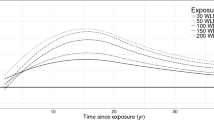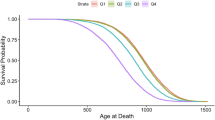Abstract
Procedures for age-adjustment of cancer fractions are proposed which do not require fixed age intervals. The full available information on survival times can then be used, which is especially important in small treatment groups. For incidental cancers a non-decreasing prevalence function and for fatal cancers the Kaplan-Meier estimator is used. In the latter case, the estimated competing risk of the control population is standardized, not its true survival. This makes the technique also applicable to treatment groups with high incidence, which otherwise may give adjusted rates above 100%. In the application part these age-adjustment techniques are used here to study lung cancer in radon-exposed Wistar and Sprague-Dawley rats. The data include a classification in fatal and incidental lung cancers. For fatal lung cancer, the lifetime excess absolute risk (LEAR) at 1 WLM averaged over all exposed groups is 0.67×10−4 for the Wistar rats, while for the Sprague-Dawley rats it is 0.40×10−4. For the Sprague-Dawley rats, there are several groups exposed later in life. When the averaging is restricted to animals with start of exposure prior to 150 days of age, the weighted average risk among the Sprague-Dawley rats is 0.79×10−4. Compared to groups with similar exposures as young adults (up to about 150 days), animals exposed later in life have substantially lower lifetime risks. The Wistar rats include groups with roughly equal exposure rates and ages at start of exposure, but with increasing exposure duration. Within these groupings the LEAR at 1 WLM does not decrease with additional exposure at higher age, as would be expected if the risk from exposures at different ages would be additive.



Similar content being viewed by others
References
Majo VD, Rebessi S, Pazzaglia S, Saran A, Covelli V (2003) Carcinogenesis in laboratory mice after low doses of ionizing radiation. Radiat Res 159:102–108
Ullrich RL, Jernigan MC, Storer JB (1977) Neutron carcinogenesis. Dose and dose-rate effects in BALB/c mice. Radiat Res 72:487–498
Peto R, Pike MC, Day NE et al. (1980) Annex: Guidelines for simple, sensitive significance tests for carcinogenic effects in long-term animal experiments. In: Long-term and short-term screening assays for carcinogens: a critical appraisal. IARC Monographs, Supplement 2, Lyon, pp 311–426
Hoel DG, Walburg HE (1971) Statistical analysis of survival experiments. J Natl Cancer Inst 49:361–372
Kaiser JC, Heidenreich WF, Monchaux G, Morlier JP, Collier CG (2004) Lung tumour risk in radon-exposed rats from different experiments: comparative analysis with biologically based models. Radiat Environ Biophys 43 DOI 10.1007/s00411-004-0251-x
Storer JB, Mitchell TJ, Fry RJ (1988) Extrapolation of the relative risk of radiogenic neoplasms across mouse strains and to man. Radiat Res 114:331–353
Heidenreich WF, Jacob P, Paretzke HG, Cross FT, Dagle GE (1999) Two step model for fatal and incidental lung tumor risk in rats exposed to radon. Radiat Res 151:209–217
Gilbert ES, Cross FT, Dagle GE (1996) Analysis of lung tumor risks in rats exposed to radon. Radiat Res 145:350–360
Acknowledgments
This work was supported by the EU under contract number CT-1999–0013.
Author information
Authors and Affiliations
Corresponding author
Appendix
Appendix
The Appendix provides the mathematical formulas to the concepts in the text. The following notation is used:
-
S(t) is the probability of surviving to age t
-
P T (t) is the probability of developing a cancer to age t. It is also called the prevalence function
-
\( h_{T} (t) = {\mathop {\dot{P}}\nolimits_T }(t)/(1 - P_{T} (t)) \) is the hazard rate
-
Fatal cancers terminate the life of an animal; the other animals die of competing risks. The survival function for competing risks is S c (t)=S(t)/(1−P T (t))
-
Incidental cancers do not change the lifespan of an animal, so all animals die of competing risks, S c (t)=S(t).
In these formulas age t can be measured from birth, or e.g. begin of follow-up.
With this notation, the expected fraction of cancers in a treatment group of animals is:
For fatal cancers, this is equivalent to the expression:
For a group of animals with the same exposure pattern and with survival times t j , j = 1...N, this is for fatal cancers equivalent to:
for incidental cancers, Eq. 1 is equivalent to
If the competing survival is described by a piecewise constant function (e.g. by a Kaplan-Meier estimate) with S c,i in the interval t i , ti+1, then the last integral in Eq. 1 gives:
This formula is used in the calculations of age-adjusted fractions in this paper.
In the age-adjustment of fatal cancers:
-
P T (t) is the Kaplan-Meier estimate in each treatment group
-
S c (t) is the Kaplan-Meier estimate for all deaths except the fatal cancers in the control group.
In the age-adjustment of incidental cancers
-
P T (t) is the non-decreasing estimate of incidence [3, 4] in each treatment group
-
S c (t) is the survival function of the control group.
The data sets used here provide a classification in fatal and incidental lung cancers. When their sum is age-adjusted, the expected lifetime of animals has to be formed from the survival functions for the end-points “except fatal lung cancer” in the controls, and “fatal lung cancer” in the exposed group. Therefore, in this case S c (t) in Eqs. 1 and 3 has to be defined as the product of the Kaplan-Meier estimate for “all deaths except the fatal cancers” in the control group, and \( (1 - P^{f}_{T} (t)) \) where \( P^{f}_{T} (t) \) is the Kaplan-Meier estimate of the probability to develop a fatal lung cancer in the exposed group.
It may be of some interest to rewrite the direct age-adjustment in the language of Eqs. 1 and 3. Direct age-adjustment [2] uses fixed time-intervals i and the formula
where n i is the number of cases in interval i in the exposed group, and N is the total number of animals in the control group. For incidental cancers, m i is the number of deaths in the exposed group, and M i in the control group, in interval i. For fatal cancers m i is the time at risk in the exposed group, and M i in the control group, in interval i.
Direct age-adjustment for incidental cancers estimates the incidence function P T (t) in the exposed groups, and the change of the survival function ΔS(t) in the control group in fixed age intervals, and replaces the left integral in Eq. 1 by a sum over the intervals. Consequently it differs from the technique here only in using fixed intervals versus variable intervals.
For fatal cancers direct age-adjustment estimates the hazard h(t) of the treatment groups in fixed intervals, and the product of the survival function S(t) of the controls with the length of the time interval, and it replaces the integral in Eq. 2 by a sum over the intervals. Consequently it differs from the technique here in using fixed intervals versus variable intervals, and by using the survival function of the controls, while the product of the competing survival of the controls and the cancer survival of the exposed group is used here.
The lifetime excess absolute risk at 1 WLM r is calculated for groups with total exposure D from the age-adjusted fractions: it is assumed that the fraction (1−f(D)) of animals free of cancer is the product of the fraction (1−f0) of animals free of spontaneously occurring cancer, times the fraction (1−r) which has no cancer induced by 1 WLM of exposure, to the power of exposure in WLM:
Expansion to linear order in f0 and r gives the usual expression
In these formulas r is the lifetime excess absolute risk after exposure to 1 WLM. Inverting Eq. 5 gives
It has two sources of uncertainty, a random one from the fraction f(D), and one from the spontaneous fraction f0, which is acting in all treatment groups in the same direction.
The lifetime excess relative risk at 1 WLM can be obtained by dividing the absolute risk by the spontaneous fraction:
Rights and permissions
About this article
Cite this article
Heidenreich, W.F., Collier, C., Morlier, J.P. et al. Age-adjustment in experimental animal data and its application to lung cancer in radon-exposed rats. Radiat Environ Biophys 43, 183–188 (2004). https://doi.org/10.1007/s00411-004-0250-y
Received:
Accepted:
Published:
Issue Date:
DOI: https://doi.org/10.1007/s00411-004-0250-y




